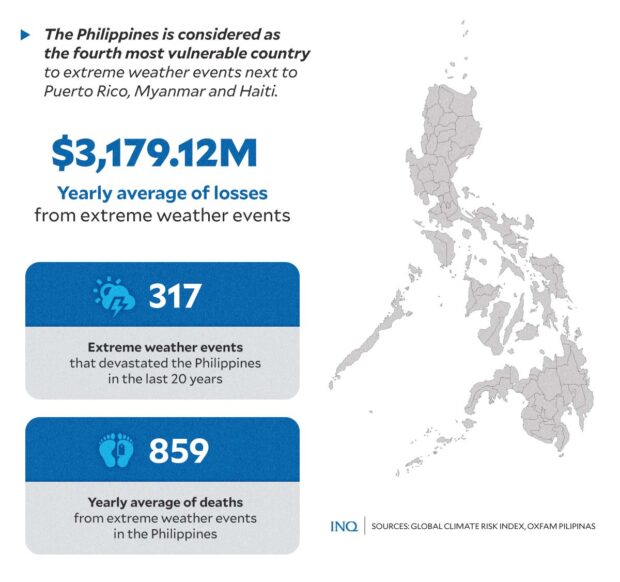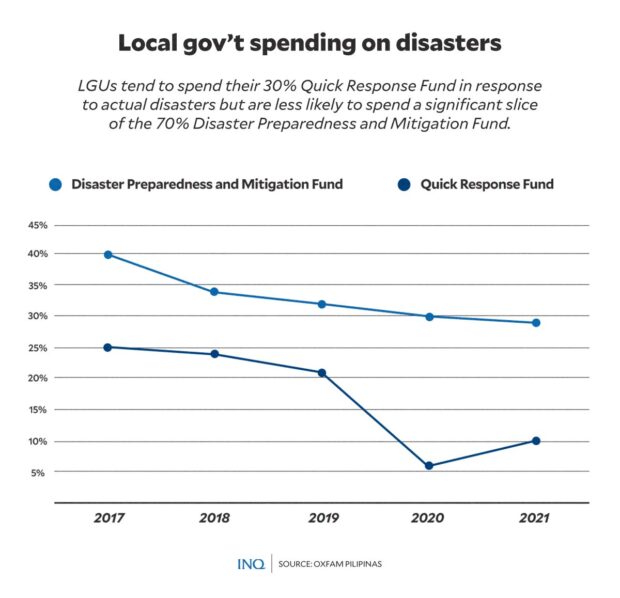Ounce of prevention better than pound of cure in times of disaster—Oxfam tells LGUs
MANILA, Philippines—Local government units (LGUs) should shift from reactive to proactive spending, a humanitarian and development organization said, stressing that the best way to mitigate the damage caused by disasters is to prepare.
This was pointed out by Oxfam Pilipinas as the country marked the 10th anniversary of Yolanda (Haiyan), one of the world’s strongest typhoons that hit over 14 million people in 46 provinces.
For Erika Geronimo, executive director of Oxfam Pilipinas, “we learned the hard way that the best way to reduce the impacts of a climate crisis is by preparing early for an imminent disaster.”
She said “we cannot afford another Haiyan devastating people’s lives.”
“It will be better if local governments proactively utilized their 70 percent mitigation/preparedness funds that do not require a declaration of state of calamity instead of merely expending their 30 percent QRF (Quick Response Fund) when disaster strikes,” she said.
Article continues after this advertisementREAD: Worry about severe weather events among highest in PH
As explained by Oxfam Pilipinas, LGUs are required by law to apportion 70 percent of their Local Disaster Risk Reduction and Management Fund (LDRRMF) for mitigation and prevention, and 30 percent for response and recovery.
Article continues after this advertisementHowever, even after Yolanda, Oxfam said while LGUs spend their 30 percent QRF in response to actual disasters, they are less likely to make use of a significant share of the 70 percent fund for preparedness and mitigation.
Hit hard
The Philippines, based on the Global Climate Risk Index, is the fourth most vulnerable to extreme weather events such as typhoons, next to Puerto Rico, Myanmar, and Haiti, from 2000 to 2019.
READ: PH 4th most affected by extreme weather–report
It was pointed out that in the last 20 years, 317 extreme weather events devastated the country, resulting in a yearly average of 859 deaths and $3,179.2 million in losses, with the poor considered the hardest hit.
The Index classifies countries in two broad categories—those that had experienced exceptional catastrophes such as Myanmar, and those that had experienced and are experiencing extreme weather events on an ongoing basis, like the Philippines.
RELATED STORY: Don’t care about climate change? Wait until it hits you in the face
Based on a latest study by Oxfam Pilipinas, which examined how LGUs were spending their LDRRMF, mitigation and prevention, together with preparedness, got the biggest slice as required by the Philippines Disaster Risk Reduction and Management Act of 2012.
The problem, however, is how much of these resources were actually used.
Spending less
The Oxfam study “Local Disaster Risk Reduction and Management Fund Utilization Patterns and Opportunities for Improvement” revealed that at first glance, LGUs seem compliant with the 70 percent-30 percent allocation.
As Oxfam Pilipinas said, the indicative distribution of LDRRMF were mitigation/prevention (42.20 percent), response (32.4 percent), preparedness (21.2 percent), and recovery/rehabilitation (4.3 percent).
However, the year-on-year underspending trend is concerning.
Based on data, while underspending of the 70 percent mitigation/prevention funds lessened from 41 percent in 2017 to 30 percent in 2021, underspending of QRF dropped from 25 percent to 10 percent over the same period.
RELATED STORY: DENR urges youth to take part in solving climate crisis
For Oxfam Pilipinas, this means that LGUs were using the QRF more, indicating again its “reactive” attitude towards disaster risk despite the need for a proactive one such as prevention and preparedness.
Needed change
Oxfam stressed that based on its projection, the trend will still be the same for the next five years.
Spending of the 70 percent mitigation/prevention funds and the 30 percent QRF was likely to improve but 11 percent of prevention funds is still expected to be underutilized by 2026 while funds for actual disaster will run out.
Almost 10 years ago, the Commission on Audit had already expressed concern over the government’s spending pattern characterized largely as “reactive, insufficient, inefficient and for the most part, too slow.”
Oxfam Pilipinas said that “sub-optimal use of government funds and other resources bodes ill to the welfare of the public,” stressing that “reduced spending can be construed as less presence of the government.”
For Esteban Masagca, executive director of People’s Disaster Risk Reduction Network, “inclusive and community-based disaster preparedness, along with anticipatory actions such as pre-disaster cash assistance, are effective strategies to reduce the devastating effects of the climate crisis.”



